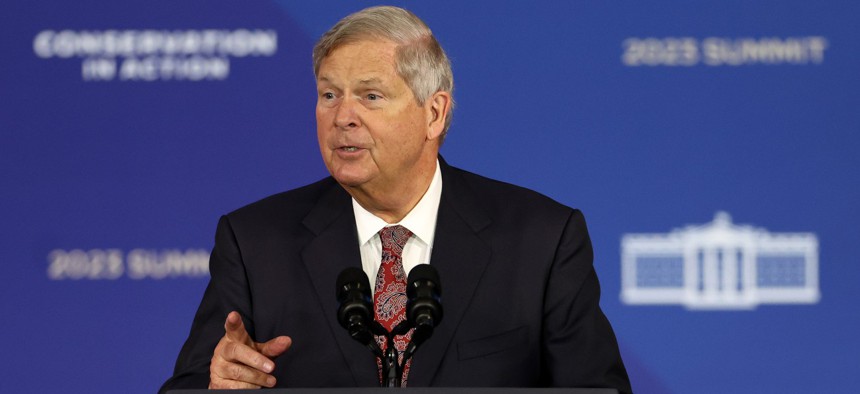
Agriculture Secretary Tom Vilsack said better care for federal firefighters "means better pay and benefits, better housing, better mental and physical health resources, and better work-life balance." Kevin Dietsch/Getty Images
More Federal Firefighter Pay and Benefits Reforms Are Highlighted in the 2024 Budget
President Biden’s fiscal 2024 budget proposal would make temporary pay raises authorized by the bipartisan infrastructure law permanent.
The White House this week outlined how President Biden’s fiscal 2024 budget proposal continues to focus on improving the compensation and wellbeing of federal wildland firefighters, setting aside more than $4 billion for wildfire management.
Under Biden’s funding roadmap for next year, the Agriculture and Interior departments would receive $4.2 billion to increase pay, improve benefits and hire additional wildland firefighters, as well as invest in new equipment.
Reforming wildland firefighters’ pay and benefits has been a priority for Biden since early in his administration, due to the fact that many federal firefighters made less than the president’s desired $15 hourly minimum wage for federal employment, creating a pay disparity between federally employed firefighters and their state and local counterparts.
In 2021, Biden announced a combination of retention incentives and cash awards to boost their pay to $15 for that year. And last June, Biden authorized pay raises of $20,000 per year or 50% of their current base salary, whichever was lower, for two years, using funding authorized by the bipartisan infrastructure law.
Biden’s fiscal 2024 budget includes $252 million in spending that would make those temporary raises permanent by creating a special base rate salary table for all federal wildland firefighters and a new premium pay category that provides responders with additional compensation for all hours they are mobilized in response to a fire incident. The Agriculture Department said this funding would need to be accompanied by additional legislation authorizing the new pay table and premium pay.
The budget also proposes an additional $111 million to increase staffing by roughly 1,400 firefighters and support personnel and to pay for additional premium pay.
“This will ensure that the agencies can effectively meet the demands of wildland fires year-round while improving the work-life balance of firefighters,” USDA wrote. “In total, the budget will support the equivalent of 970 additional federal firefighters and support personnel for USDA and 370 more federal personnel for [the Interior Department]. The budget for [Interior] also will support the equivalent of 55 more tribal wildland fire personnel than the fiscal 2023 enacted level.”
Additional proposed funding to improve wildland firefighters’ wellbeing includes $20 million to establish year-round mental health support training, post-traumatic stress care and other trauma services through the Joint Wildland Firefighter Behavior Health Program. Another $72 million would go toward providing housing for wildland firefighters in areas where there is limited or unaffordable housing stock.
“Wildland firefighters save lives, protect communities and serve on the frontlines to confront our nation’s wildfire crisis,” said Agriculture Secretary Tom Vilsack in a statement this month. “We must take better care of them in return by addressing challenges that have plagued them for decades. Better care means better pay and benefits, better housing, better mental and physical health resources, and better work-life balance for these people who have given so much.”
National Federation of Federal Employees National President Randy Erwin, whose union represents around 10,000 federal wildland firefighters, applauded the administration’s continued focus on the federal government’s wildfire suppression workforce.
“With this proposed budget, it is clear the White House has heard our plea for additional resources,” he said. “The Biden administration understands the dire need for wildland firefighter workforce reform, and the president is delivering on his commitments to support the brave women and men protecting our communities from the wildland fire crisis . . . These reforms will help the U.S. Forest Service recruit and retain skilled personnel and better serve the American people.”







